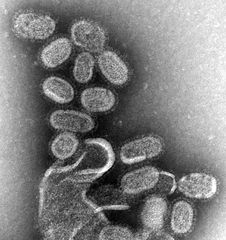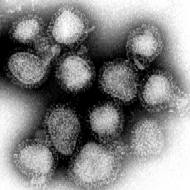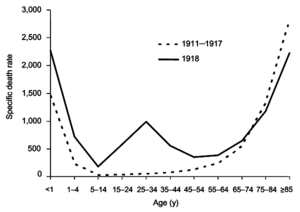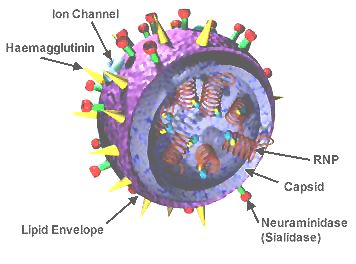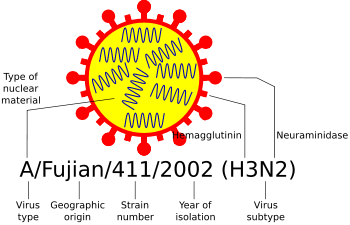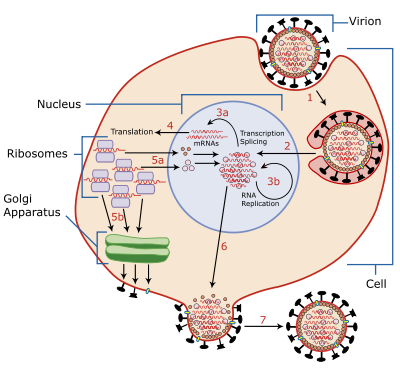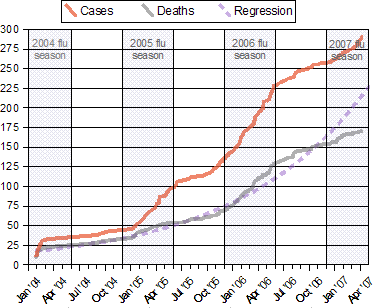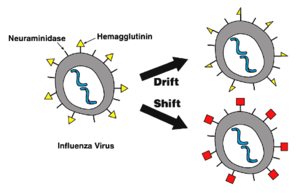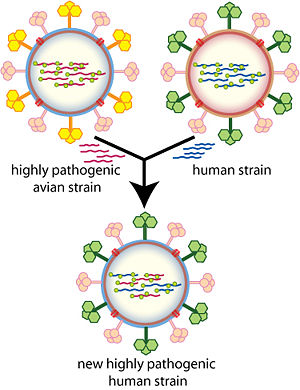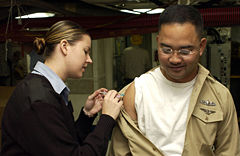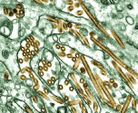Influenza
2008/9 Schools Wikipedia Selection. Related subjects: Health and medicine
| Influenza Classification and external resources |
|
| TEM of negatively stained influenza virons, magnified approximately 100,000 times | |
| ICD- 10 | J 10., J 11. |
| ICD- 9 | 487 |
| DiseasesDB | 6791 |
| MedlinePlus | 000080 |
| eMedicine | med/1170 ped/3006 |
| MeSH | D007251 |
Influenza, commonly known as flu, is an infectious disease of birds and mammals caused by RNA viruses of the family Orthomyxoviridae (the influenza viruses). The name influenza comes from the Italian: influenza, meaning "influence", (Latin: influentia). In humans, common symptoms of the disease are chills and fever, sore throat, muscle pains, severe headache, coughing, weakness and general discomfort. In more serious cases, influenza causes pneumonia, which can be fatal, particularly in young children and the elderly. Although it is sometimes confused with the common cold, influenza is a much more severe disease and is caused by a different type of virus. Influenza can produce nausea and vomiting, especially in children, but these symptoms are more characteristic of the unrelated gastroenteritis, which is sometimes called "stomach flu" or "24-hour flu".
Typically influenza is transmitted from infected mammals through the air by coughs or sneezes, creating aerosols containing the virus, and from infected birds through their droppings. Influenza can also be transmitted by saliva, nasal secretions, faeces and blood. Infections also occur through contact with these body fluids or with contaminated surfaces. Flu viruses can remain infectious for about one week at human body temperature, over 30 days at 0 °C (32 °F), and for much longer periods at very low temperatures. Most influenza strains can be inactivated easily by disinfectants and detergents.
Flu spreads around the world in seasonal epidemics, killing millions of people in pandemic years and hundreds of thousands in non-pandemic years. Three influenza pandemics occurred in the 20th century and killed tens of millions of people, with each of these pandemics being caused by the appearance of a new strain of the virus in humans. Often, these new strains result from the spread of an existing flu virus to humans from other animal species. A deadly avian strain named H5N1 has posed the greatest risk for a new influenza pandemic since it first killed humans in Asia in the 1990s. Fortunately, this virus has not mutated to a form that spreads easily between people.
Vaccinations against influenza are usually given to people in developed countries with a high risk of contracting the disease and to farmed poultry. The most common human vaccine is the trivalent influenza vaccine that contains purified and inactivated material from three viral strains. Typically, this vaccine includes material from two influenza A virus subtypes and one influenza B virus strain. A vaccine formulated for one year may be ineffective in the following year, since the influenza virus changes rapidly over time, and different strains become dominant. Antiviral drugs can be used to treat influenza, with neuraminidase inhibitors being particularly effective.
|
Etymology
The word influenza comes from the Italian language and refers to the cause of a disease; initially, this ascribed illness to unfavorable astrological influences. Changes in medical thought led to its modification to influenza del freddo, meaning "influence of the cold". The word influenza was first used in English in 1743 when it was adopted, with an anglicized pronunciation, during an outbreak of the disease in Europe. Archaic terms for influenza include epidemic catarrh, grippe (from the French), sweating sickness, and Spanish fever (particularly for the 1918 pandemic strain).
History
The symptoms of human influenza were clearly described by Hippocrates roughly 2,400 years ago. Since then, the virus has caused numerous pandemics. Historical data on influenza are difficult to interpret, because the symptoms can be similar to those of other diseases, such as diphtheria, pneumonic plague, typhoid fever, dengue, or typhus. The first convincing record of an influenza pandemic was of an outbreak in 1580, which began in Asia and spread to Europe via Africa. In Rome, over 8,000 people were killed, and several Spanish cities were almost wiped out. Pandemics continued sporadically throughout the 17th and 18th centuries, with the pandemic of 1830–1833 being particularly widespread; it infected approximately a quarter of the people exposed.
The most famous and lethal outbreak was the so-called Spanish flu pandemic ( type A influenza, H1N1 subtype), which lasted from 1918 to 1919. Older estimates say it killed 40–50 million people, while current estimates say 50 million to 100 million people worldwide were killed. This pandemic has been described as "the greatest medical holocaust in history" and may have killed as many people as the Black Death. This huge death toll was caused by an extremely high infection rate of up to 50% and the extreme severity of the symptoms, suspected to be caused by cytokine storms. Indeed, symptoms in 1918 were so unusual that initially influenza was misdiagnosed as dengue, cholera, or typhoid. One observer wrote, "One of the most striking of the complications was hemorrhage from mucous membranes, especially from the nose, stomach, and intestine. Bleeding from the ears and petechial hemorrhages in the skin also occurred." The majority of deaths were from bacterial pneumonia, a secondary infection caused by influenza, but the virus also killed people directly, causing massive hemorrhages and edema in the lung.
The Spanish flu pandemic was truly global, spreading even to the Arctic and remote Pacific islands. The unusually severe disease killed between 2 and 20% of those infected, as opposed to the more usual flu epidemic mortality rate of 0.1%. Another unusual feature of this pandemic was that it mostly killed young adults, with 99% of pandemic influenza deaths occurring in people under 65, and more than half in young adults 20 to 40 years old. This is unusual since influenza is normally most deadly to the very young (under age 2) and the very old (over age 70). The total mortality of the 1918–1919 pandemic is not known, but it is estimated that 2.5% to 5% of the world's population was killed. As many as 25 million may have been killed in the first 25 weeks; in contrast, HIV/AIDS has killed 25 million in its first 25 years.
Later flu pandemics were not so devastating. They included the 1957 Asian Flu (type A, H2N2 strain) and the 1968 Hong Kong Flu (type A, H3N2 strain), but even these smaller outbreaks killed millions of people. In later pandemics antibiotics were available to control secondary infections and this may have helped reduce mortality compared to the Spanish Flu of 1918.
| Name of pandemic | Date | Deaths | Subtype involved | Pandemic Severity Index |
|---|---|---|---|---|
| Asiatic (Russian) Flu | 1889–1890 | 1 million | possibly H2N2 | ? |
| Spanish Flu | 1918–1920 | 40 to 100 million | H1N1 | 5 |
| Asian Flu | 1957–1958 | 1 to 1.5 million | H2N2 | 2 |
| Hong Kong Flu | 1968–1969 | 0.75 to 1 million | H3N2 | 2 |
The etiological cause of influenza, the Orthomyxoviridae family of viruses, was first discovered in pigs by Richard Schope in 1931. This discovery was shortly followed by the isolation of the virus from humans by a group headed by Patrick Laidlaw at the Medical Research Council of the United Kingdom in 1933. However, it was not until Wendell Stanley first crystallized tobacco mosaic virus in 1935 that the non-cellular nature of viruses was appreciated.
The first significant step towards preventing influenza was the development in 1944 of a killed-virus vaccine for influenza by Thomas Francis, Jr.. This built on work by Frank Macfarlane Burnet, who showed that the virus lost virulence when it was cultured in fertilized hen's eggs. Application of this observation by Francis allowed his group of researchers at the University of Michigan to develop the first influenza vaccine, with support from the U.S. Army. The Army was deeply involved in this research due to its experience of influenza in World War I, when thousands of troops were killed by the virus in a matter of months.
Although there were scares in New Jersey in 1976 (with the Swine Flu), worldwide in 1977 (with the Russian Flu), and in Hong Kong and other Asian countries in 1997 (with H5N1 avian influenza), there have been no major pandemics since the 1968 Hong Kong Flu. Immunity to previous pandemic influenza strains and vaccination may have limited the spread of the virus and may have helped prevent further pandemics.
Microbiology
Types of influenza virus
The influenza virus is an RNA virus of the family Orthomyxoviridae, which comprises five genera:
- Influenzavirus A
- Influenzavirus B
- Influenzavirus C
- Isavirus
- Thogotovirus
Influenzavirus A
This genus has one species, influenza A virus. Wild aquatic birds are the natural hosts for a large variety of influenza A. Occasionally, viruses are transmitted to other species and may then cause devastating outbreaks in domestic poultry or give rise to human influenza pandemics. The type A viruses are the most virulent human pathogens among the three influenza types and cause the most severe disease. The influenza A virus can be subdivided into different serotypes based on the antibody response to these viruses. The serotypes that have been confirmed in humans, ordered by the number of known human pandemic deaths, are:
- H1N1, which caused Spanish flu in 1918
- H2N2, which caused Asian Flu in 1957
- H3N2, which caused Hong Kong Flu in 1968
- H5N1, a pandemic threat in the 2007–08 flu season
- H7N7, which has unusual zoonotic potential
- H1N2, endemic in humans and pigs
- H9N2
- H7N2
- H7N3
- H10N7
Influenzavirus B
This genus has one species, influenza B virus. Influenza B almost exclusively infects humans and is less common than influenza A. The only other animal known to be susceptible to influenza B infection is the seal. This type of influenza mutates at a rate 2–3 times lower than type A and consequently is less genetically diverse, with only one influenza B serotype. As a result of this lack of antigenic diversity, a degree of immunity to influenza B is usually acquired at an early age. However, influenza B mutates enough that lasting immunity is not possible. This reduced rate of antigenic change, combined with its limited host range (inhibiting cross species antigenic shift), ensures that pandemics of influenza B do not occur.
Influenzavirus C
This genus has one species, influenza C virus, which infects humans and pigs and can cause severe illness and local epidemics. However, influenza C is less common than the other types and usually seems to cause mild disease in children.
Structure and properties
Influenzaviruses A, B and C are very similar in structure. The virus particle is 80–120 nanometres in diameter and usually roughly spherical, although filamentous forms can occur. Unusually for a virus, its genome is not a single piece of nucleic acid; instead, it contains seven or eight pieces of segmented negative-sense RNA. The Influenza A genome encodes 11 proteins: hemagglutinin (HA), neuraminidase (NA), nucleoprotein (NP), M1, M2, NS1, NS2(NEP), PA, PB1, PB1-F2 and PB2.
HA and NA are large glycoproteins on the outside of the viral particles. HA is a lectin that mediates binding of the virus to target cells and entry of the viral genome into the target cell, while NA is involved in the release of progeny virus from infected cells, by cleaving sugars that bind the mature viral particles. Thus, these proteins are targets for antiviral drugs. Furthermore, they are antigens to which antibodies can be raised. Influenza A viruses are classified into subtypes based on antibody responses to HA and NA, forming the basis of the H and N distinctions in, for example, H5N1.
Infection and replication
Influenza viruses bind through hemagglutinin onto sialic acid sugars on the surfaces of epithelial cells; typically in the nose, throat and lungs of mammals and intestines of birds (Stage 1 in infection figure). The cell imports the virus by endocytosis. In the acidic endosome, part of the hemagglutinin protein fuses the viral envelope with the vacuole's membrane, releasing the viral RNA (vRNA) molecules, accessory proteins and RNA-dependent RNA polymerase into the cytoplasm (Stage 2). These proteins and vRNA form a complex that is transported into the cell nucleus, where the RNA-dependent RNA polymerase begins transcribing complementary positive-sense vRNA (Steps 3a and b). The vRNA is either exported into the cytoplasm and translated (step 4), or remains in the nucleus. Newly-synthesised viral proteins are either secreted through the Golgi apparatus onto the cell surface (in the case of neuraminidase and hemagglutinin, step 5b) or transported back into the nucleus to bind vRNA and form new viral genome particles (step 5a). Other viral proteins have multiple actions in the host cell, including degrading cellular mRNA and using the released nucleotides for vRNA synthesis and also inhibiting translation of host-cell mRNAs.
Negative-sense vRNAs that form the genomes of future viruses, RNA-dependent RNA polymerase, and other viral proteins are assembled into a virion. Hemagglutinin and neuraminidase molecules cluster into a bulge in the cell membrane. The vRNA and viral core proteins leave the nucleus and enter this membrane protrusion (step 6). The mature virus buds off from the cell in a sphere of host phospholipid membrane, acquiring hemagglutinin and neuraminidase with this membrane coat (step 7). As before, the viruses adhere to the cell through hemagglutinin; the mature viruses detach once their neuraminidase has cleaved sialic acid residues from the host cell. After the release of new influenza viruses, the host cell dies.
Because of the absence of RNA proofreading enzymes, the RNA-dependent RNA polymerase makes a single nucleotide insertion error roughly every 10 thousand nucleotides, which is the approximate length of the influenza vRNA. Hence, nearly every newly-manufactured influenza virus is a mutant—antigenic drift. The separation of the genome into eight separate segments of vRNA allows mixing or reassortment of vRNAs if more than one viral line has infected a single cell. The resulting rapid change in viral genetics produces antigenic shifts and allows the virus to infect new host species and quickly overcome protective immunity. This is important in the emergence of pandemics, as discussed below in the section on Epidemiology.
Symptoms and diagnosis
In humans, influenza's effects are much more severe and last longer than those of the common cold. Recovery takes about one to two weeks. Influenza, however, can be deadly, especially for the weak, old or chronically ill. The flu can worsen chronic health problems. People with emphysema, chronic bronchitis or asthma may experience shortness of breath while they have the flu, and influenza may cause worsening of coronary heart disease or congestive heart failure. Smoking is another risk factor associated with more serious disease and increased mortality from influenza.
Symptoms
Symptoms of influenza can start quite suddenly one to two days after infection. Usually the first symptoms are chills or a chilly sensation, but fever is also common early in the infection, with body temperatures as high as 39 °C (approximately 103 °F). Many people are so ill that they are confined to bed for several days, with aches and pains throughout their bodies, which are worse in their backs and legs. Symptoms of influenza may include:
It can be difficult to distinguish between the common cold and influenza in the early stages of these infections, but usually the symptoms of the flu are more severe than their common cold equivalents. Research on signs and symptoms of influenza found that the best findings for excluding the diagnosis of influenza were:
| Finding: | sensitivity | specificity |
|---|---|---|
| Fever | 86% | 25% |
| Cough | 98% | 23% |
| Nasal congestion | 70–90% | 20–40% |
Notes to table:
- Sensitivity is the proportion of people who tested positive of all the positive people tested. In this case, being positive or negative is having influenza or not, and being tested positive or negative is having the symptom or not. For instance, 86% of those with influenza had fever.
- Specificity is the proportion of people who tested negative of all the negative people tested. In this case, the ones without fever only constitute 25% of those without influenza. In other words, the majority of people with fever do not have influenza.
- All three findings, especially fever, were less sensitive in patients over 60 years of age.
Since anti-viral drugs are effective in treating influenza if given early (see treatment section, below), it can be important to identify cases early. Of the symptoms listed above, the combinations of findings below can improve diagnostic accuracy. Unfortunately, even combinations of findings are imperfect. However, Bayes Theorem can combine pretest probability with clinical findings to adequately diagnose or exclude influenza in some patients. The pretest probability has a strong seasonal variation; the current prevalence of influenza among patients in the United States receiving sentinel testing is available at the CDC. Using the CDC data, the following table shows how the likelihood of influenza varies with prevalence:
| Combinations of findings | Sensitivity | Specificity | As reported in study and projected during local outbreaks (prevalence=66%) |
Projected during influenza season (prevalence=25%) |
Projected in off-season (prevalence=2%) |
|||
|---|---|---|---|---|---|---|---|---|
| PPV | NPV | PPV | NPV | PPV | NPV | |||
| Fever and cough | 64% | 67% | 79% | 49% | 39% | 15% | 4% | 1% |
| Fever and cough and sore throat | 56 | 71 | 79 | 45 | 39 | 17 | 4 | 2 |
| Fever and cough and nasal congestion | 59 | 74 | 81 | 48 | 43 | 16 | 4 | 1 |
Two decision analysis studies suggest that during local outbreaks of influenza, the prevalence will be over 70%, and thus patients with any of the above combinations of symptoms may be treated with neuramidase inhibitors without testing. Even in the absence of a local outbreak, treatment may be justified in the elderly during the influenza season as long as the prevalence is over 15%.
Most people who get influenza will recover in one to two weeks, but others will develop life-threatening complications (such as pneumonia). According to the World Health Organization: "Every winter, tens of millions of people get the flu. Most are only ill and out of work for a week, yet the elderly are at a higher risk of death from the illness. We know the world-wide death toll exceeds a few hundred thousand people a year, but even in developed countries the numbers are uncertain, because medical authorities don't usually verify who actually died of influenza and who died of a flu-like illness." Even healthy people can be affected, and serious problems from influenza can happen at any age. People over 50 years old, very young children and people of any age with chronic medical conditions are more likely to get complications from influenza, such as pneumonia, bronchitis, sinus, and ear infections.
Common symptoms of the flu such as fever, headaches, and fatigue come from the huge amounts of proinflammatory cytokines and chemokines (such as interferon or tumor necrosis factor) produced from influenza-infected cells. In contrast to the rhinovirus that causes the common cold, influenza does cause tissue damage, so symptoms are not entirely due to the inflammatory response.
Laboratory tests
The available laboratory tests for influenza continue to improve. The United States Centers for Disease Control and Prevention (CDC) maintains an up-to-date summary of available laboratory tests. According to the CDC, rapid diagnostic tests have a sensitivity of 70–75% and specificity of 90–95% when compared with viral culture. These tests may be especially useful during the influenza season (prevalence=25%) but in the absence of a local outbreak, or peri-influenza season (prevalence=10%).
Epidemiology
Seasonal variations
Influenza reaches peak prevalence in winter, and because the Northern and Southern Hemispheres have winter at different times of the year, there are actually two different flu seasons each year. This is why the World Health Organization (assisted by the National Influenza Centers) makes recommendations for two different vaccine formulations every year; one for the Northern, and one for the Southern Hemisphere.
It is not completely clear why outbreaks of the flu occur seasonally rather than uniformly throughout the year. One possible explanation is that, because people are indoors more often during the winter, they are in close contact more often, and this promotes transmission from person to person. Another is that cold temperatures lead to drier air, which may dehydrate mucus, preventing the body from effectively expelling virus particles. The virus may also survive longer on exposed surfaces (doorknobs, countertops, etc.) in colder temperatures. Increased travel due to the Northern Hemisphere winter holiday season may also play a role. A contributing factor is that aerosol transmission of the virus is highest in cold environments (less than 5 °C) with low humidity. However, seasonal changes in infection rates also occur in tropical regions, and these peaks of infection are seen mainly during the rainy season. Seasonal changes in contact rates from school terms, which are a major factor in other childhood diseases such as measles and pertussis, may also play a role in the flu. A combination of these small seasonal effects may be amplified by dynamical resonance with the endogenous disease cycles. H5N1 exhibits seasonality in both humans and birds.
An alternative hypothesis to explain seasonality in influenza infections is an effect of vitamin D levels on immunity to the virus. This idea was first proposed by Robert Edgar Hope-Simpson in 1965. He proposed that the cause of influenza epidemics during winter may be connected to seasonal fluctuations of vitamin D, which is produced in the skin under the influence of solar (or artificial) UV radiation. This could explain why influenza occurs mostly in winter and during the tropical rainy season, when people stay indoors, away from the sun, and their vitamin D levels fall.
Epidemic and pandemic spread
As influenza is caused by a variety of species and strains of viruses, in any given year some strains can die out while others create epidemics, while yet another strain can cause a pandemic. Typically, in a year's normal two flu seasons (one per hemisphere), there are between three and five million cases of severe illness and up to 500,000 deaths worldwide, which by some definitions is a yearly influenza epidemic. Although the incidence of influenza can vary widely between years, approximately 36,000 deaths and more than 200,000 hospitalizations are directly associated with influenza every year in America. Every ten to twenty years, a pandemic occurs, which infects a large proportion of the world's population and can kill tens of millions of people (see history section).
New influenza viruses are constantly being produced by mutation or by reassortment. Mutations can cause small changes in the hemagglutinin and neuraminidase antigens on the surface of the virus. This is called antigenic drift, which creates an increasing variety of strains over time until one of the variants eventually achieves higher fitness, becomes dominant, and rapidly sweeps through the human population—often causing an epidemic. In contrast, when influenza viruses reassort, they may acquire new antigens—for example by reassortment between avian strains and human strains; this is called antigenic shift. If a human influenza virus is produced with entirely novel antigens, everybody will be susceptible, and the novel influenza will spread uncontrollably, causing a pandemic. In contrast to this model of pandemics based on antigenic drift and shift, an alternative approach has been proposed where the periodic pandemics are produced by interactions of a fixed set of viral strains with a human population with a constantly changing set of immunities to different viral strains.
Prevention
Vaccination and infection control
Vaccination against influenza with an influenza vaccine is often recommended for high-risk groups, such as children and the elderly. Influenza vaccines can be produced in several ways; the most common method is to grow the virus in fertilized hen eggs. After purification, the virus is inactivated (for example, by treatment with detergent) to produce an inactivated-virus vaccine. Alternatively, the virus can be grown in eggs until it loses virulence and the avirulent virus given as a live vaccine. The effectiveness of these influenza vaccines is variable. Due to the high mutation rate of the virus, a particular influenza vaccine usually confers protection for no more than a few years. Every year, the World Health Organization predicts which strains of the virus are most likely to be circulating in the next year, allowing pharmaceutical companies to develop vaccines that will provide the best immunity against these strains. Vaccines have also been developed to protect poultry from avian influenza. These vaccines can be effective against multiple strains and are used either as part of a preventative strategy, or combined with culling in attempts to eradicate outbreaks.
It is possible to get vaccinated and still get influenza. The vaccine is reformulated each season for a few specific flu strains but cannot possibly include all the strains actively infecting people in the world for that season. It takes about six months for the manufacturers to formulate and produce the millions of doses required to deal with the seasonal epidemics; occasionally, a new or overlooked strain becomes prominent during that time and infects people although they have been vaccinated (as by the H3N2 Fujian flu in the 2003–2004 flu season). It is also possible to get infected just before vaccination and get sick with the very strain that the vaccine is supposed to prevent, as the vaccine takes about two weeks to become effective.
The 2006–2007 season was the first in which the CDC had recommended that children younger than 59 months receive the annual influenza vaccine. Vaccines can cause the immune system to react as if the body were actually being infected, and general infection symptoms (many cold and flu symptoms are just general infection symptoms) can appear, though these symptoms are usually not as severe or long-lasting as influenza. The most dangerous side-effect is a severe allergic reaction to either the virus material itself or residues from the hen eggs used to grow the influenza; however, these reactions are extremely rare.
Good personal health and hygiene habits are reasonably effective in avoiding and minimizing influenza. People who contract influenza are most infective between the second and third days after infection and infectivity lasts for around ten days. Children are notably more infectious than adults and shed virus from just before they develop symptoms until two weeks after infection.
Since influenza spreads through aerosols and contact with contaminated surfaces, it is important to persuade people to cover their mouths while sneezing and to wash their hands regularly. Surface sanitizing is recommended in areas where influenza may be present on surfaces. Alcohol is an effective sanitizer against influenza viruses, while quaternary ammonium compounds can be used with alcohol to increase the duration of the sanitizing action. In hospitals, quaternary ammonium compounds and halogen-releasing agents such as sodium hypochlorite are commonly used to sanitize rooms or equipment that have been occupied by patients with influenza symptoms. During past pandemics, closing schools, churches and theaters slowed the spread of the virus but did not have a large effect on the overall death rate.
Treatment
People with the flu are advised to get plenty of rest, drink a lot of liquids, avoid using alcohol and tobacco and, if necessary, take medications such as paracetamol (acetaminophen) to relieve the fever and muscle aches associated with the flu. Children and teenagers with flu symptoms (particularly fever) should avoid taking aspirin during an influenza infection (especially influenza type B), because doing so can lead to Reye's syndrome, a rare but potentially fatal disease of the liver. Since influenza is caused by a virus, antibiotics have no effect on the infection; unless prescribed for secondary infections such as bacterial pneumonia, they may lead to resistant bacteria. Antiviral medication is sometimes effective, but viruses can develop resistance to the standard antiviral drugs.
The two classes of anti-virals are neuraminidase inhibitors and M2 inhibitors ( adamantane derivatives). Neuraminidase inhibitors are currently preferred for flu virus infections. The CDC recommended against using M2 inhibitors during the 2005–06 influenza season.
Neuraminidase inhibitors
Antiviral drugs such as oseltamivir (trade name Tamiflu) and zanamivir (trade name Relenza) are neuraminidase inhibitors that are designed to halt the spread of the virus in the body. These drugs are often effective against both influenza A and B. The Cochrane Collaboration reviewed these drugs and concluded that they reduce symptoms and complications. Different strains of influenza viruses have differing degrees of resistance against these antivirals, and it is impossible to predict what degree of resistance a future pandemic strain might have.
M2 inhibitors (adamantanes)
The antiviral drugs amantadine and rimantadine are designed to block a viral ion channel ( M2 protein) and prevent the virus from infecting cells. These drugs are sometimes effective against influenza A if given early in the infection but are always ineffective against influenza B. Measured resistance to amantadine and rimantadine in American isolates of H3N2 has increased to 91% in 2005.
Research
Research on influenza includes studies on molecular virology, how the virus produces disease ( pathogenesis), host immune responses, viral genomics, and how the virus spreads ( epidemiology). These studies help in developing influenza countermeasures; for example, a better understanding of the body's immune system response helps vaccine development, and a detailed picture of how influenza invades cells aids the development of antiviral drugs. One important basic research program is the Influenza Genome Sequencing Project, which is creating a library of influenza sequences; this library should help clarify which factors make one strain more lethal than another, which genes most affect immunogenicity, and how the virus evolves over time.
Research into new vaccines is particularly important, as current vaccines are very slow and expensive to produce and must be reformulated every year. The sequencing of the influenza genome and recombinant DNA technology may accelerate the generation of new vaccine strains by allowing scientists to substitute new antigens into a previously developed vaccine strain. New technologies are also being developed to grow viruses in cell culture, which promises higher yields, less cost, better quality and surge capacity. Research on a universal influenza A vaccine, targeted against the external domain of the transmembrane viral M2 protein (M2e), is being done at the University of Ghent by Walter Fiers, Xavier Saelens and their team and has now successfully concluded Phase I clinical trials.
The US government has purchased several million doses of vaccine from Sanofi Pasteur and Chiron Corporation, meant to be used in case of an influenza pandemic of H5N1 avian influenza and is conducting clinical trials with these vaccines. The UK government is also stockpiling millions of doses of antiviral drugs (oseltamivir (Tamiflu), zanimivir (Relanza)) to give to its citizens in the event of an outbreak; the UK Health Protection Agency has also gathered a limited amount of HPAI H5N1 vaccines for experimental purposes.
Infection in other animals
|
Influenza infects many animal species, and transfer of viral strains between species can occur. Birds are thought to be the main animal reservoirs of influenza viruses. Sixteen forms of hemagglutinin and nine forms of neuraminidase have been identified. All known subtypes (HxNy) are found in birds, but many subtypes are endemic in humans, dogs, horses, and pigs; populations of camels, ferrets, cats, seals, mink, and whales also show evidence of prior infection or exposure to influenza. Variants of flu virus are sometimes named according to the species the strain is endemic in or adapted to. The main variants named using this convention are: Bird Flu, Human Flu, Swine Flu, Horse Flu and Dog Flu. ( Cat flu generally refers to Feline viral rhinotracheitis or Feline calicivirus and not infection from an influenza virus.) In pigs, horses and dogs, influenza symptoms are similar to humans, with cough, fever and loss of appetite. The frequency of animal diseases are not as well-studied as human infection, but an outbreak of influenza in harbour seals caused approximately 500 seal deaths off the New England coast in 1979–1980. On the other hand, outbreaks in pigs are common and do not cause severe mortality.
Flu symptoms in birds are variable and can be unspecific. The symptoms following infection with low-pathogenicity avian influenza may be as mild as ruffled feathers, a small reduction in egg production, or weight loss combined with minor respiratory disease. Since these mild symptoms can make diagnosis in the field difficult, tracking the spread of avian influenza requires laboratory testing of samples from infected birds. Some strains such as Asian H9N2 are highly virulent to poultry and may cause more extreme symptoms and significant mortality. In its most highly pathogenic form, influenza in chickens and turkeys produces a sudden appearance of severe symptoms and almost 100% mortality within two days. As the virus spreads rapidly in the crowded conditions seen in the intensive farming of chickens and turkeys, these outbreaks can cause large economic losses to poultry farmers.
An avian-adapted, highly pathogenic strain of H5N1 (called HPAI A(H5N1), for "highly pathogenic avian influenza virus of type A of subtype H5N1") causes H5N1 flu, commonly known as "avian influenza" or simply "bird flu", and is endemic in many bird populations, especially in Southeast Asia. This Asian lineage strain of HPAI A(H5N1) is spreading globally. It is epizootic (an epidemic in non-humans) and panzootic (a disease affecting animals of many species, especially over a wide area), killing tens of millions of birds and spurring the culling of hundreds of millions of other birds in an attempt to control its spread. Most references in the media to "bird flu" and most references to H5N1 are about this specific strain.
At present, HPAI A(H5N1) is an avian disease, and there is no evidence suggesting efficient human-to-human transmission of HPAI A(H5N1). In almost all cases, those infected have had extensive physical contact with infected birds. In the future, H5N1 may mutate or reassort into a strain capable of efficient human-to-human transmission. Due to its high lethality and virulence, its endemic presence, and its large and increasing biological host reservoir, the H5N1 virus was the world's pandemic threat in the 2006–07 flu season, and billions of dollars are being raised and spent researching H5N1 and preparing for a potential influenza pandemic.
Economic impact
Influenza produces direct costs due to lost productivity and associated medical treatment, as well as indirect costs of preventative measures. In the United States, influenza is responsible for a total cost of over $10 billion per year, while it has been estimated that a future pandemic could cause hundreds of billions of dollars in direct and indirect costs. However, the economic impacts of past pandemics have not been intensively studied, and some authors have suggested that the Spanish influenza actually had a positive long-term effect on per-capita income growth, despite a large reduction in the working population and severe short-term depressive effects. Other studies have attempted to predict the costs of a pandemic as serious as the 1918 Spanish flu on the U.S. economy, where 30% of all workers became ill, and 2.5% were killed. A 30% sickness rate and a three-week length of illness would decrease the gross domestic product by 5%. Additional costs would come from medical treatment of 18 million to 45 million people, and total economic costs would be approximately $700 billion.
Preventative costs are also high. Governments worldwide have spent billions of U.S. dollars preparing and planning for a potential H5N1 avian influenza pandemic, with costs associated with purchasing drugs and vaccines as well as developing disaster drills and strategies for improved border controls. On November 1, 2005, President George W. Bush unveiled the National Strategy to Safeguard Against the Danger of Pandemic Influenza backed by a request to Congress for $7.1 billion to begin implementing the plan. Internationally, on January 18, 2006, donor nations pledged US$2 billion to combat bird flu at the two-day International Pledging Conference on Avian and Human Influenza held in China.
As of 2006, over ten billion dollars have been spent, and over two hundred million birds have been killed to try to contain H5N1 avian influenza. However, as these efforts have been largely ineffective at controlling the spread of the virus, other approaches are being tried: for example, the Vietnamese government in 2005 adopted a combination of mass poultry vaccination, disinfecting, culling, information campaigns and bans on live poultry in cities. As a result of such measures, the cost of poultry farming has increased, while the cost to consumers has gone down due to demand for poultry falling below supply. This has resulted in devastating losses for many farmers. Poor poultry farmers cannot afford mandated measures which isolate their bird livestock from contact with wild birds (among other measures), thus risking losing their livelihood altogether. Multinational poultry farming is increasingly becoming unprofitable as H5N1 avian influenza becomes endemic in wild birds worldwide. Financial ruin for poor poultry farmers, which can be as severe as threatening starvation, has caused some to commit suicide and many others to stop cooperating with efforts to deal with this virus—further increasing the human toll, the spread of the disease, and the chances of a pandemic mutation.
